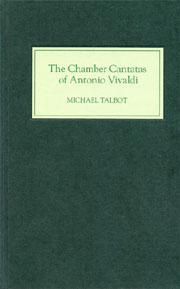Book contents
- Frontmatter
- Contents
- List of music examples
- List of tables
- Preface
- Conventions and abbreviations
- 1 The Rediscovery of Vivaldi's Cantatas
- 2 The Cantata Genre
- 3 Vivaldi and the Voice
- 4 The Mantuan Cantatas
- 5 Cantatas of the Middle Years
- 6 The Dresden Cantatas
- 7 Vivaldi's Cantatas in Perspective
- Glossary
- List of Vivaldi's cantatas published in the New Critical Edition
- Spurious works
- Bibliography
- Index to musical works
- General index
7 - Vivaldi's Cantatas in Perspective
Published online by Cambridge University Press: 12 September 2012
- Frontmatter
- Contents
- List of music examples
- List of tables
- Preface
- Conventions and abbreviations
- 1 The Rediscovery of Vivaldi's Cantatas
- 2 The Cantata Genre
- 3 Vivaldi and the Voice
- 4 The Mantuan Cantatas
- 5 Cantatas of the Middle Years
- 6 The Dresden Cantatas
- 7 Vivaldi's Cantatas in Perspective
- Glossary
- List of Vivaldi's cantatas published in the New Critical Edition
- Spurious works
- Bibliography
- Index to musical works
- General index
Summary
The Cantata within Vivaldi's Oeuvre
The cantata stands a little apart from the other domains that Vivaldi cultivated. One symptom of this is the rarity with which the material of his cantatas – and, above all, of his continuo cantatas – recurs in his works belonging to other genres. Whereas a slow movement of a violin sonata may pop up as that of a concerto, or the theme of a concerto ritornello reappear in an operatic aria, such specific links involving themes in the fullest sense (as opposed to motives and figures) are hardly ever encountered between his cantatas and his other music. Since Vivaldi was in general such an inveterate self-borrower, we need to consider why.
Part of the reason lies in simple statistics. The great majority of Vivaldi's cantatas are for voice and continuo. Vivaldi began to compose them in quantity (during the Mantua years) at a point when continuo arias were beginning to disappear entirely from his (and other composer's) operas. The opportunity for exchange in bulk between cantata arias and operatic arias was therefore lost. In any case, Vivaldi had developed a sensitivity for the text–music relationship that prevented him from making such exchanges too freely. Most cantata aria texts differ from most operatic aria texts in style and content. The elegiac, pastorally tinged tone of a typical cantata aria corresponds to that of only a very small subtype of operatic aria.
- Type
- Chapter
- Information
- The Chamber Cantatas of Antonio Vivaldi , pp. 188 - 200Publisher: Boydell & BrewerPrint publication year: 2006



